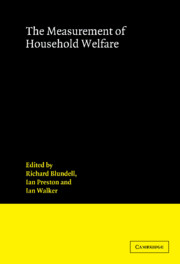Book contents
- Frontmatter
- Contents
- List of contributors
- 1 An introduction to applied welfare analysis
- 2 Measuring the cost of children: a theoretical framework
- 3 The collective approach to household behaviour
- 4 Ordinal and cardinal utility: an integration of the two dimensions of the welfare concept
- 5 The determination of welfare in nonintact families
- 6 Female labour supply, housework and family welfare
- 7 Engel equivalence scales in Sri Lanka: exactness, specification, measurement error
- 8 Measuring the life-cycle consumption costs of children
- 9 Family fortunes in the 1970s and 1980s
- 10 Ethically-consistent welfare prescriptions are reference price-independent
- 11 The effect of systematic misperception of income on the subjective poverty line
- Index of names
- Index of subjects
2 - Measuring the cost of children: a theoretical framework
Published online by Cambridge University Press: 13 January 2010
- Frontmatter
- Contents
- List of contributors
- 1 An introduction to applied welfare analysis
- 2 Measuring the cost of children: a theoretical framework
- 3 The collective approach to household behaviour
- 4 Ordinal and cardinal utility: an integration of the two dimensions of the welfare concept
- 5 The determination of welfare in nonintact families
- 6 Female labour supply, housework and family welfare
- 7 Engel equivalence scales in Sri Lanka: exactness, specification, measurement error
- 8 Measuring the life-cycle consumption costs of children
- 9 Family fortunes in the 1970s and 1980s
- 10 Ethically-consistent welfare prescriptions are reference price-independent
- 11 The effect of systematic misperception of income on the subjective poverty line
- Index of names
- Index of subjects
Summary
Introduction
Parenthood has costs as well as benefits. Children must be fed, clothed, housed, and educated, and the resulting expenditures leave parents with less to spend on themselves. In addition, because some governments attempt to compensate families for the costs of children, reasonable estimates of the costs of children are a prerequisite for sensible policies.
But how should the costs of children be measured? We might choose, for example, to assume that the costs of a first child are the same for all families, regardless of income, or we might choose to include or disregard the psychic benefits to parents. In addition, because parents cannot typically imagine the childless alternative, interpersonal comparisons of levels of well-being between individuals in different households are necessary for the construction of sensible indexes.
This chapter presents a theoretical framework for indexes of the costs of children using a methodology that is closely related to household equivalence scale techniques (see, as an example, Blackorby and Donaldson, 1988, 1991). Households' demand behaviour is assumed to be rationalised by standard preferences, individuals in each household are assumed to be equally well off, and comparisons of levels of utility between individuals in different households are assumed to be possible (see p. 52 below).
In this framework, we introduce general classes of cost-of-children indexes (p. 53). The first class – relative cost-of-children indexes – regards the cost as equal in percentage terms for all households, while the second class – absolute cost-of-children indexes – regards the cost as equal in absolute terms.
- Type
- Chapter
- Information
- The Measurement of Household Welfare , pp. 51 - 69Publisher: Cambridge University PressPrint publication year: 1994
- 14
- Cited by



